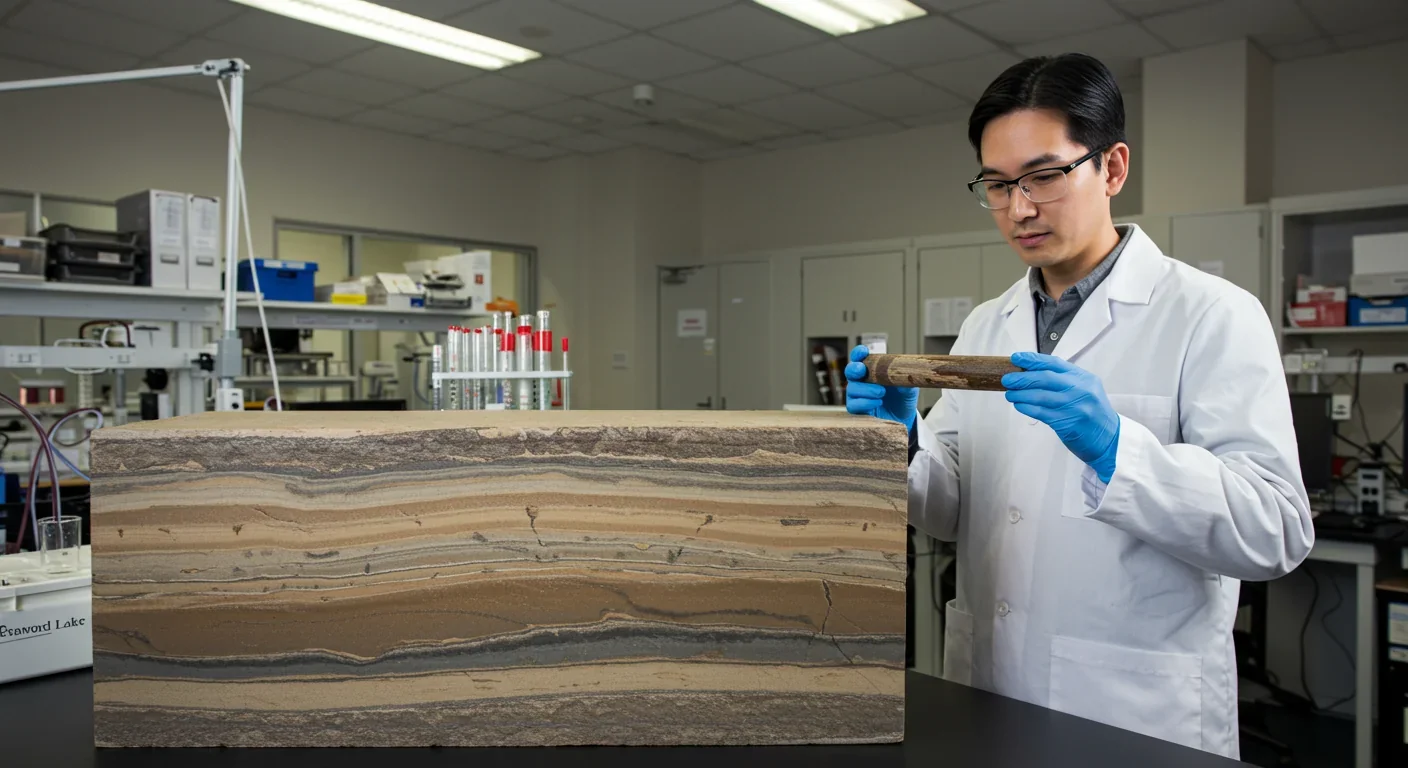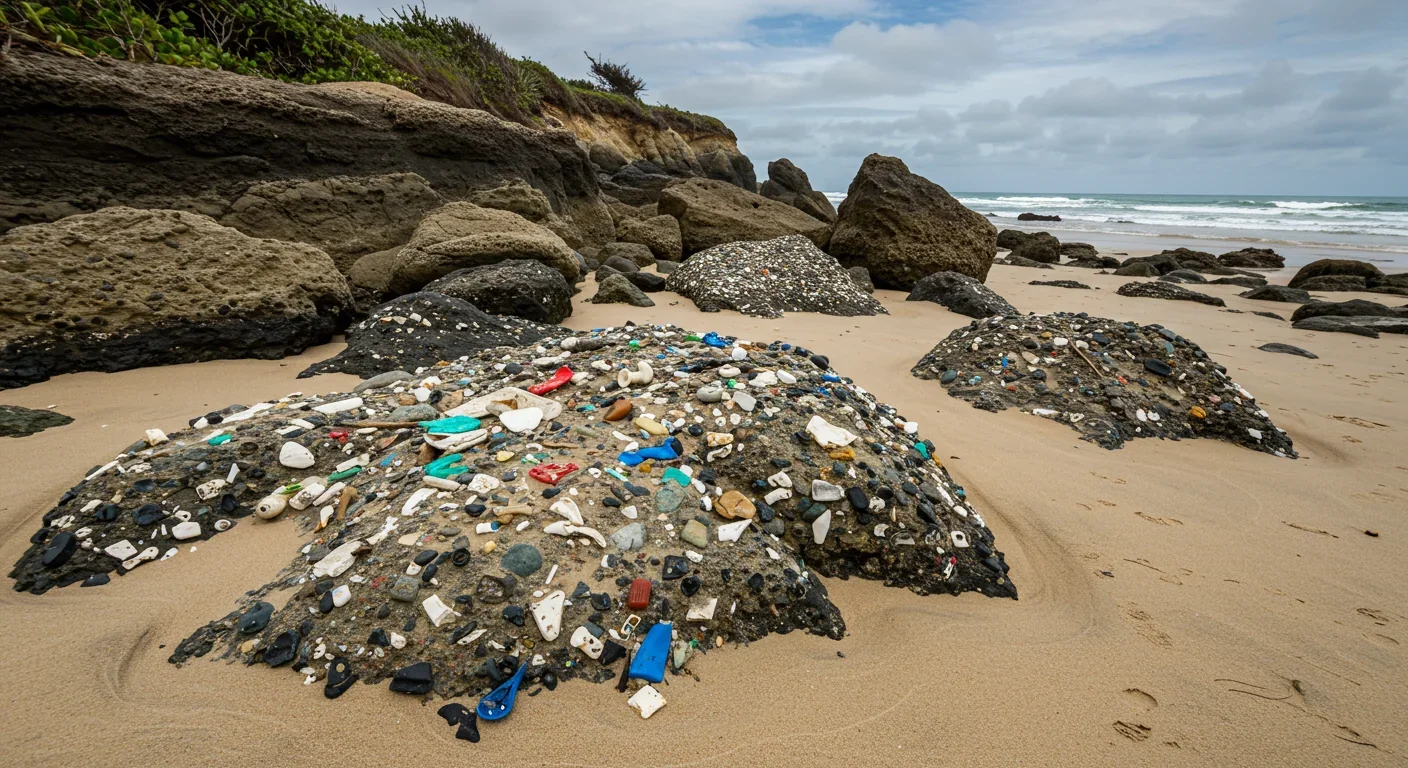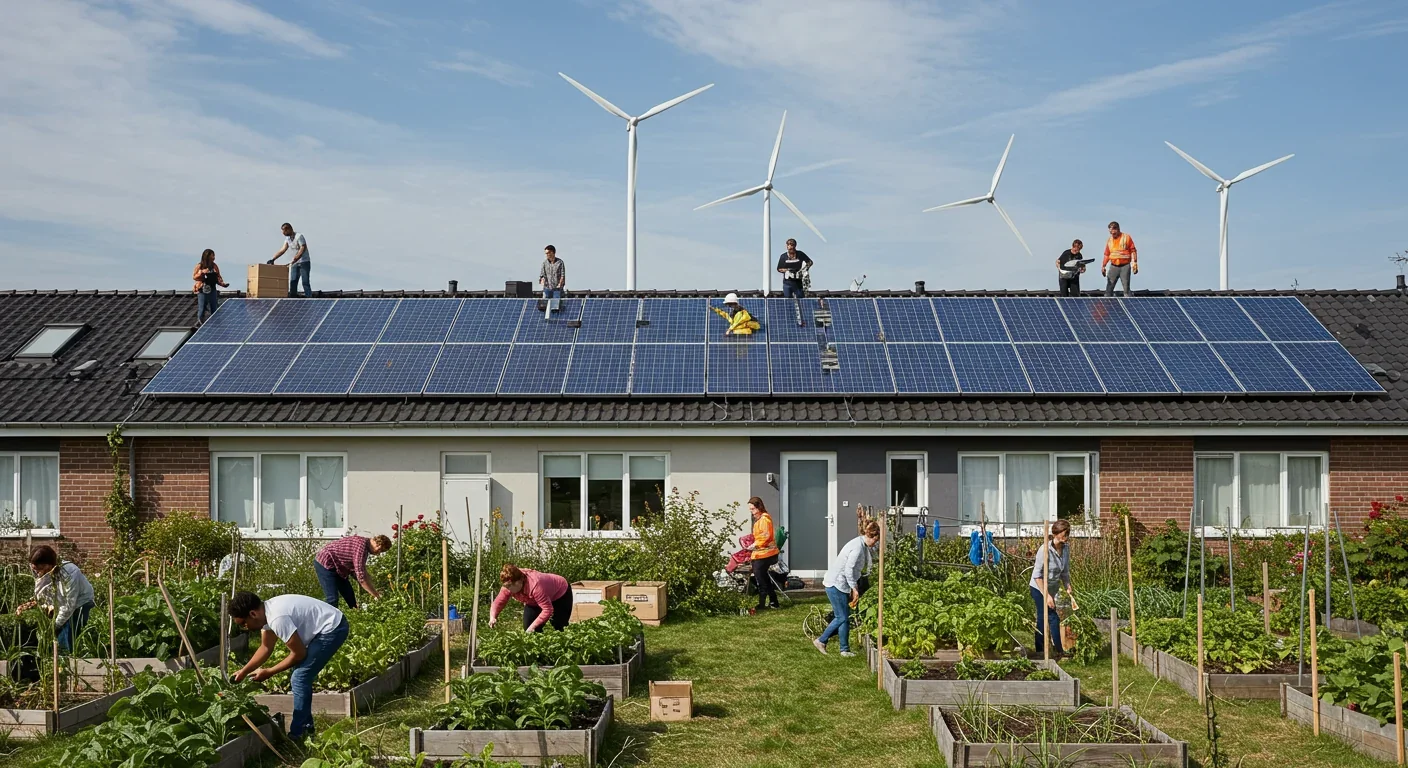Digital Pollution Tax: Can It Save Data Centers?

TL;DR: Humans have become a geological force, leaving permanent markers in Earth's rock layers from plutonium to plastics. While scientists debate formal recognition, the Anthropocene is already reshaping our planet and demands urgent collective action.

By 2100, geologists studying Earth's rock layers will discover an unmistakable boundary. Above it, sediments are laced with plutonium isotopes, microplastics, and fossilized chicken bones—markers of a civilization that burned through millions of years of stored carbon in just two centuries. Below it, the planet looks entirely different. This line separates the Holocene from the Anthropocene, the proposed new geological epoch where humans aren't just inhabitants of Earth but its dominant sculptors.
The Anthropocene isn't science fiction. It's happening right now, and the evidence is literally piling up beneath our feet.
The story begins at an unlikely place: a small, unassuming lake in Ontario, Canada. Crawford Lake holds a thousand years of human history in its sediment layers, preserved with astonishing clarity. Each year deposits a distinct varve—a thin band of sediment—creating a timeline you can read like tree rings.
Researchers examining Crawford Lake's sediment cores found something remarkable. The varve from 1945 contains plutonium isotopes from the first atomic bomb test at Los Alamos. The 1950s layers show fly ash from coal-burning steel mills. Indigenous farming signatures—corn and sunflower pollen—appear in sediments from the late 1200s, long before industrialization.
"Crawford Lake's records highlight over 30 generations of activity and illustrate how humans have altered the world," says Dr. Søren Brothers, ROM Curator of Climate Change. The lake was selected in 2023 as the leading candidate for a "golden spike"—the physical marker that would officially define the Anthropocene's start.
But here's where it gets complicated: scientists can't agree on when this new epoch actually began.
Some researchers argue the Anthropocene started with the Industrial Revolution in the 1800s, when coal smoke first began changing atmospheric chemistry. Others point to the mid-20th century "Great Acceleration"—the explosive post-WWII growth in population, consumption, and pollution. A few suggest it began 8,000 years ago with early agriculture, when humans first started reshaping landscapes.
The debate isn't just academic hairsplitting. It reflects fundamental disagreements about what defines a geological epoch and how much human impact qualifies as "epoch-making."
Traditional geological boundaries are marked by mass extinctions, major climate shifts, or the appearance of new rock types—events visible in stone millions of years later. The Anthropocene Working Group, tasked with evaluating the proposal, faced a challenge: how do you declare a new epoch when you're still living in it?
In March 2024, the International Union of Geological Sciences voted against formally recognizing the Anthropocene as a geological epoch—at least for now. The decision sparked controversy. Critics argued the rejection was procedural rather than scientific, while supporters said it reflected legitimate concerns about rushing to judgment on geological timescales.
Yet the scientific evidence keeps mounting, and the term "Anthropocene" has already reshaped how we understand our relationship with the planet.
Walk into any geological lab studying recent sediments, and you'll see the markers of human influence stacking up like evidence at a crime scene.
Plutonium and radionuclides from nuclear weapons testing during the Cold War created a global radioactive signature. These isotopes settled into sediments worldwide, creating a synchronous marker visible from the Arctic to the Antarctic. Future geologists will have no trouble identifying this layer—it's as distinct as the iridium band that marks the dinosaur extinction.
Microplastics have infiltrated every environment on Earth. Researchers find them in Arctic ice cores, deep ocean trenches, and mountain lake sediments. These future fossils will persist for millennia, creating a plastic layer in the geological record that future scientists will call the "plastiglomerate horizon."
Concrete and aluminum production has left distinctive chemical signatures. Humans now move more sediment through construction than all natural erosional processes combined. We've literally reshaped the planet's surface.
Atmospheric carbon dioxide has reached 420 parts per million—levels not seen for 3 million years. Ice cores preserve this atmospheric history in trapped air bubbles, creating an undeniable record of industrial-era carbon emissions.
Mass extinction rates now exceed background levels by 100 to 1,000 times. Current extinction rates approach those of the five major mass extinctions in Earth's history, and scientists project 16% of species could vanish if warming reaches 4.3°C.
Nitrogen and phosphorus cycles have been completely altered by fertilizer production. The Haber-Bosch process for synthesizing ammonia has doubled the amount of reactive nitrogen in the biosphere, fundamentally changing soil chemistry and ocean composition.
These aren't subtle changes. They're planetary-scale transformations that will remain visible in the rock record long after our cities have crumbled.

Human influence on Earth isn't new—we've been modifying our environment since we learned to control fire. But the scale has changed dramatically.
For 95% of human existence, we were relatively light on the land. Hunter-gatherers altered ecosystems through controlled burns and hunting, contributing to megafauna extinctions around 50,000 years ago. But these impacts were localized and slow.
The Agricultural Revolution 10,000 years ago marked our first major planetary transformation. Clearing forests for crops changed regional climates and began the long process of selecting certain plant and animal species over others. Domestication created entirely new organisms—modern corn looks nothing like its wild ancestor.
The Industrial Revolution accelerated everything. Coal, then oil and gas, gave us access to millions of years of stored solar energy. We burned through this inheritance in just a few generations, releasing ancient carbon back into the atmosphere and fundamentally altering the planet's heat balance.
But the real explosion came after 1950. The Great Acceleration saw near-vertical curves in every graph: population, GDP, fertilizer use, dam construction, international travel, McDonald's restaurants. Pick any metric of human activity, and you'll see the same hockey-stick pattern.
We went from local landscape modifiers to planetary-scale geoengineers in the span of a single human lifetime.
Understanding why the Anthropocene matters requires grasping how geologists define epochs in the first place.
The geological timescale is divided based on major transitions visible in the rock record—changes in fossil assemblages, isotope ratios, or mineral compositions that mark fundamental shifts in Earth systems. These boundaries must be globally synchronous (happening everywhere at roughly the same time) and permanently recorded in sediments.
The Anthropocene meets these criteria in ways that previous human-induced changes did not. While earlier agricultural impacts were regionally variable and diachronous (happening at different times in different places), mid-20th century markers like plutonium fallout and microplastics appear simultaneously in sediments worldwide.
This is why many scientists favor starting the Anthropocene around 1950 rather than earlier. The Great Acceleration created truly global, synchronous signals that will be unambiguous to future stratigraphers examining the rock record millions of years from now.
Stratigraphic evidence—the physical layers in rocks—provides the smoking gun. When future geologists core through sediments, they'll see an abrupt transition from Holocene conditions (stable climate, low extinction rates, natural element cycles) to Anthropocene conditions (rapidly warming climate, mass extinction, radically altered biogeochemical cycles).
The debate over formalizing the Anthropocene might seem like geological inside baseball, but it carries real-world implications.
For climate policy, recognizing the Anthropocene acknowledges that we've fundamentally altered Earth systems and can't return to some pristine baseline. This shifts the conversation from "preventing climate change" (which has already occurred) to "managing the planet we've created."
For public perception, the term reframes humanity's relationship with nature. We're not separate from natural systems—we're now the dominant force shaping them. This recognition can be paralyzing or empowering, depending on how it's framed.
For international cooperation, the Anthropocene concept highlights that planetary boundaries don't respect national borders. Seven of nine planetary boundaries have now been breached, creating shared risks that require coordinated responses.
Yet the formal geological designation almost doesn't matter. Whether or not the International Commission on Stratigraphy officially recognizes it, the Anthropocene has already become a powerful organizing concept across disciplines—from philosophy to economics to art.
The term appears in thousands of scientific papers annually and has entered popular consciousness in ways that geological epoch names rarely do. When was the last time you heard someone casually reference the Pliocene?
The Anthropocene isn't just an abstract concept for future geologists. Its effects are visible right now in ways that touch everyday life.
Coral reefs are experiencing unprecedented bleaching events. The Great Barrier Reef has lost half its coral cover since 1995, transforming vibrant underwater cities into ghostly graveyards. These ecosystems support a quarter of all marine species and provide food for 500 million people.
Arctic sea ice is disappearing at rates that consistently exceed scientific predictions. The Northwest Passage—sought by explorers for centuries—is now routinely navigable, fundamentally altering global shipping routes and geopolitics.
Megafauna are vanishing. African elephant populations declined by 30% between 2007 and 2014. Wild tiger numbers dropped from 100,000 a century ago to fewer than 4,000 today. We're losing the planet's charismatic megafauna within a single human lifetime.
Sea levels are rising 3.4 millimeters per year, accelerating as ice sheets destabilize. Low-lying island nations like Tuvalu and the Maldives face existential threats. By 2100, hundreds of millions of people in coastal cities will need to relocate.
Weather patterns are shifting in ways that disrupt agriculture, water supplies, and infrastructure designed for historical climate conditions. The jet stream is becoming wavier, causing persistent droughts and floods. Growing zones are migrating poleward, forcing farmers to adapt or fail.
Ocean chemistry is changing as absorbed CO₂ forms carbonic acid, lowering pH and making it harder for shellfish, corals, and plankton to build calcium carbonate structures. This threatens the base of marine food webs.
These aren't distant future scenarios. They're current realities reshaping economies, triggering migrations, and rewriting the rules of where and how humans can thrive.

The scale of the Anthropocene can feel overwhelming, so what can individuals actually do?
The honest answer is that personal actions alone won't solve planetary-scale problems. Systemic changes in energy infrastructure, industrial processes, and economic incentives matter more than whether you remember your reusable shopping bag.
But individual choices still matter—not because they'll single-handedly reverse climate change, but because they demonstrate demand for alternatives and create political pressure for larger changes.
Energy choices have outsized impacts. If you can afford it, switching to renewable electricity, weatherizing your home, and choosing electric vehicles significantly reduces your carbon footprint. Heat pumps replacing gas furnaces can cut home heating emissions by 80%.
Dietary shifts make a difference. You don't have to go vegan, but reducing beef consumption specifically has major climate benefits. Cattle ranching drives deforestation and produces methane—a greenhouse gas 28 times more potent than CO₂. Swapping beef for chicken or plant proteins even a few days a week adds up.
Flying less matters for frequent flyers. Aviation accounts for 2-3% of global emissions, but those emissions are concentrated among the small percentage of humans who fly regularly. One transatlantic flight produces more CO₂ than many people in developing countries emit in an entire year.
Supporting climate-smart agriculture through food choices encourages regenerative practices that rebuild soil carbon, reduce fertilizer use, and support biodiversity. Trophic rewilding—restoring predators and large herbivores to ecosystems—can significantly expand natural climate solutions.
Political engagement might be the most important individual action. Voting for climate-conscious candidates, supporting carbon pricing, and demanding corporate accountability creates systemic change that individual consumption choices can't achieve alone.
Financial choices increasingly matter. Where you bank, what you invest in, and which companies you support with purchases all contribute to shifting capital toward climate solutions and away from fossil fuels.
100 ways to reduce your carbon footprint with AI highlights emerging technological tools—from AI-optimized energy management to precision agriculture—that can help individuals and organizations track and reduce their climate impacts more effectively.
Perhaps the deepest challenge of the Anthropocene is psychological rather than technical. We're not biologically wired to comprehend planetary-scale impacts or think in geological timescales.
Evolution shaped human cognition for immediate threats in local environments. We're excellent at responding to clear and present dangers—a predator in the bushes, a rival tribe over the hill. We're terrible at addressing diffuse, long-term, global risks like climate change.
This cognitive mismatch explains much of our collective failure to adequately respond to Anthropocene challenges. The threat doesn't look like a threat in ways our brains recognize. It unfolds over decades rather than seconds. It requires cooperation on unprecedented scales. And it demands sacrificing immediate comforts for distant, uncertain benefits.
Yet humans also have unique capacities for abstract thinking, cultural transmission, and collective action. We've solved civilization-scale problems before—from abolishing slavery to eradicating smallpox to creating global telecommunications networks.
The question isn't whether we're capable of navigating the Anthropocene. It's whether we'll choose to do so before irreversible tipping points force adaptation under far more difficult circumstances.
We're living through one of the most significant transitions in Earth's 4.5-billion-year history. The only comparable events were the origin of life itself and the Great Oxygenation Event 2.4 billion years ago, when photosynthetic organisms fundamentally transformed the atmosphere.
The Anthropocene represents humanity's coming of age as a planetary force. Whether that force becomes one of catastrophic destruction or thoughtful stewardship remains an open question.
Future geologists—if there are any—will read the story written in stone. They'll see the boundary layer marking when one dominant species reshaped an entire planet's systems in just a few generations. What happens next depends on choices being made right now, in boardrooms and legislatures, on farms and in laboratories, and yes, in the daily decisions of billions of individuals.
The Age of Us is just beginning. The question is what kind of age it will be.

Recent breakthroughs in fusion technology—including 351,000-gauss magnetic fields, AI-driven plasma diagnostics, and net energy gain at the National Ignition Facility—are transforming fusion propulsion from science fiction to engineering frontier. Scientists now have a realistic pathway to accelerate spacecraft to 10% of light speed, enabling a 43-year journey to Alpha Centauri. While challenges remain in miniaturization, neutron management, and sustained operation, the physics barriers have ...

Epigenetic clocks measure DNA methylation patterns to calculate biological age, which predicts disease risk up to 30 years before symptoms appear. Landmark studies show that accelerated epigenetic aging forecasts cardiovascular disease, diabetes, and neurodegeneration with remarkable accuracy. Lifestyle interventions—Mediterranean diet, structured exercise, quality sleep, stress management—can measurably reverse biological aging, reducing epigenetic age by 1-2 years within months. Commercial ...

Data centers consumed 415 terawatt-hours of electricity in 2024 and will nearly double that by 2030, driven by AI's insatiable energy appetite. Despite tech giants' renewable pledges, actual emissions are up to 662% higher than reported due to accounting loopholes. A digital pollution tax—similar to Europe's carbon border tariff—could finally force the industry to invest in efficiency technologies like liquid cooling, waste heat recovery, and time-matched renewable power, transforming volunta...

Humans are hardwired to see invisible agents—gods, ghosts, conspiracies—thanks to the Hyperactive Agency Detection Device (HADD), an evolutionary survival mechanism that favored false alarms over fatal misses. This cognitive bias, rooted in brain regions like the temporoparietal junction and medial prefrontal cortex, generates religious beliefs, animistic worldviews, and conspiracy theories across all cultures. Understanding HADD doesn't eliminate belief, but it helps us recognize when our pa...

The bombardier beetle has perfected a chemical defense system that human engineers are still trying to replicate: a two-chamber micro-combustion engine that mixes hydroquinone and hydrogen peroxide to create explosive 100°C sprays at up to 500 pulses per second, aimed with 270-degree precision. This tiny insect's biochemical marvel is inspiring revolutionary technologies in aerospace propulsion, pharmaceutical delivery, and fire suppression. By 2030, beetle-inspired systems could position sat...

The U.S. faces a catastrophic care worker shortage driven by poverty-level wages, overwhelming burnout, and systemic undervaluation. With 99% of nursing homes hiring and 9.7 million openings projected by 2034, the crisis threatens patient safety, family stability, and economic productivity. Evidence-based solutions—wage reforms, streamlined training, technology integration, and policy enforcement—exist and work, but require sustained political will and cultural recognition that caregiving is ...

Every major AI model was trained on copyrighted text scraped without permission, triggering billion-dollar lawsuits and forcing a reckoning between innovation and creator rights. The future depends on finding balance between transformative AI development and fair compensation for the people whose work fuels it.